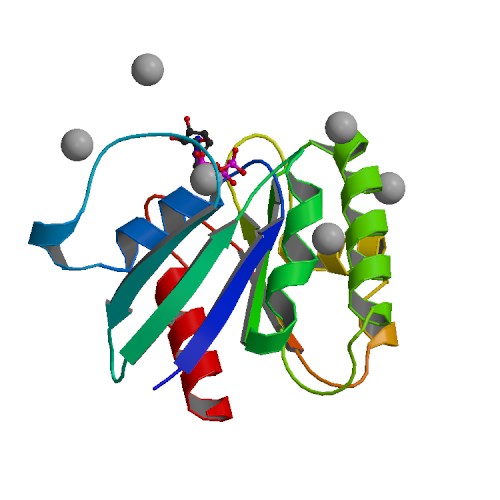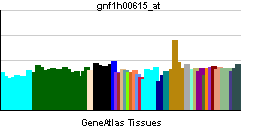ARL6
| ADP-ribosylation factor-like 6 | |||||||||||||
|---|---|---|---|---|---|---|---|---|---|---|---|---|---|
 PDB rendering based on 2h57. | |||||||||||||
| |||||||||||||
| Identifiers | |||||||||||||
| Symbols | ARL6 ; BBS3; MGC32934 | ||||||||||||
| External IDs | Template:OMIM5 Template:MGI HomoloGene: 12960 | ||||||||||||
| |||||||||||||
| RNA expression pattern | |||||||||||||
 | |||||||||||||
| More reference expression data | |||||||||||||
| Orthologs | |||||||||||||
| Template:GNF Ortholog box | |||||||||||||
| Species | Human | Mouse | |||||||||||
| Entrez | n/a | n/a | |||||||||||
| Ensembl | n/a | n/a | |||||||||||
| UniProt | n/a | n/a | |||||||||||
| RefSeq (mRNA) | n/a | n/a | |||||||||||
| RefSeq (protein) | n/a | n/a | |||||||||||
| Location (UCSC) | n/a | n/a | |||||||||||
| PubMed search | n/a | n/a | |||||||||||
ADP-ribosylation factor-like 6, also known as ARL6, is a human gene.[1]
The protein encoded by this gene belongs to the ARF family of GTP-binding proteins. ARF proteins are important regulators of cellular traffic and are the founding members of an expanding family of homologous proteins and genomic sequences. They depart from other small GTP-binding proteins by a unique structural device that implements front-back communication from the N-terminus to the nucleotide-binding site. Studies of the mouse ortholog of this protein suggest an involvement in protein transport, membrane trafficking, or cell signaling during hematopoietic maturation. Alternative splicing occurs at this locus and two transcript variants encoding the same protein have been described.[1]
References
Further reading
- Sheffield VC, Carmi R, Kwitek-Black A; et al. (1995). "Identification of a Bardet-Biedl syndrome locus on chromosome 3 and evaluation of an efficient approach to homozygosity mapping". Hum. Mol. Genet. 3 (8): 1331–5. PMID 7987310.
- Bonaldo MF, Lennon G, Soares MB (1997). "Normalization and subtraction: two approaches to facilitate gene discovery". Genome Res. 6 (9): 791–806. PMID 8889548.
- Jacobs S, Schilf C, Fliegert F; et al. (1999). "ADP-ribosylation factor (ARF)-like 4, 6, and 7 represent a subgroup of the ARF family characterization by rapid nucleotide exchange and a nuclear localization signal". FEBS Lett. 456 (3): 384–8. PMID 10462049.
- Ingley E, Williams JH, Walker CE; et al. (1999). "A novel ADP-ribosylation like factor (ARL-6), interacts with the protein-conducting channel SEC61beta subunit". FEBS Lett. 459 (1): 69–74. PMID 10508919.
- Hartley JL, Temple GF, Brasch MA (2001). "DNA cloning using in vitro site-specific recombination". Genome Res. 10 (11): 1788–95. PMID 11076863.
- Wiemann S, Weil B, Wellenreuther R; et al. (2001). "Toward a catalog of human genes and proteins: sequencing and analysis of 500 novel complete protein coding human cDNAs". Genome Res. 11 (3): 422–35. doi:10.1101/gr.154701. PMID 11230166.
- Pasqualato S, Renault L, Cherfils J (2003). "Arf, Arl, Arp and Sar proteins: a family of GTP-binding proteins with a structural device for 'front-back' communication". EMBO Rep. 3 (11): 1035–41. doi:10.1093/embo-reports/kvf221. PMID 12429613.
- Strausberg RL, Feingold EA, Grouse LH; et al. (2003). "Generation and initial analysis of more than 15,000 full-length human and mouse cDNA sequences". Proc. Natl. Acad. Sci. U.S.A. 99 (26): 16899–903. doi:10.1073/pnas.242603899. PMID 12477932.
- Chiang AP, Nishimura D, Searby C; et al. (2004). "Comparative genomic analysis identifies an ADP-ribosylation factor-like gene as the cause of Bardet-Biedl syndrome (BBS3)". Am. J. Hum. Genet. 75 (3): 475–84. doi:10.1086/423903. PMID 15258860.
- Fan Y, Esmail MA, Ansley SJ; et al. (2004). "Mutations in a member of the Ras superfamily of small GTP-binding proteins causes Bardet-Biedl syndrome". Nat. Genet. 36 (9): 989–93. doi:10.1038/ng1414. PMID 15314642.
- Gerhard DS, Wagner L, Feingold EA; et al. (2004). "The status, quality, and expansion of the NIH full-length cDNA project: the Mammalian Gene Collection (MGC)". Genome Res. 14 (10B): 2121–7. doi:10.1101/gr.2596504. PMID 15489334.
- Wiemann S, Arlt D, Huber W; et al. (2004). "From ORFeome to biology: a functional genomics pipeline". Genome Res. 14 (10B): 2136–44. doi:10.1101/gr.2576704. PMID 15489336.
- Rual JF, Venkatesan K, Hao T; et al. (2005). "Towards a proteome-scale map of the human protein-protein interaction network". Nature. 437 (7062): 1173–8. doi:10.1038/nature04209. PMID 16189514.
- Mehrle A, Rosenfelder H, Schupp I; et al. (2006). "The LIFEdb database in 2006". Nucleic Acids Res. 34 (Database issue): D415–8. doi:10.1093/nar/gkj139. PMID 16381901.
| This protein-related article is a stub. You can help Wikipedia by expanding it. |